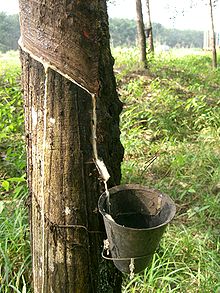Raw material


A raw material, also known as a feedstock, unprocessed material, or primary commodity, is a basic material that is used to produce goods, finished products, energy, or intermediate materials that are feedstock for future finished products. As feedstock, the term connotes these materials are bottleneck assets and are required to produce other products.
The term raw material denotes materials in unprocessed or minimally processed states; e.g., raw latex, crude oil, cotton, coal, raw biomass, iron ore, air, logs, water, or "any product of agriculture, forestry, fishing or mineral in its natural form or which has undergone the transformation required to prepare it for international marketing in substantial volumes".[1] The term secondary raw material denotes waste material which has been recycled and injected back into use as productive material.[2]
Ceramic[]
While pottery originated in many different points around the world, it is certain that it was brought to light mostly through the Neolithic Revolution. That is important mostly because of its ability to store and carry a surplus of supplies for the first agrarian. Although most jars and pots were fire-clay ceramics, Neolithic communities created kilns that were able to fire such materials to remove most of the water to create very stable and hard materials. Without the clay from the ground from that region,[clarification needed] the Neolithic Revolution would have never grew as it has in the past.[clarification needed] Using these kilns, the process of metallurgy was possible once the Bronze and Iron Ages came upon the people that lived there.[3]
Metallic[]
Many raw metallic materials used in industrial purposes must first be processed into a usable state. Metallic ores are first processed through a combination of crushing, roasting, magnetic separation, flotation, and leaching to make them suitable for use in a foundry. Foundries then smelt the ore into usable metal that may be alloyed with other materials to improve certain properties.[4] One metallic raw material that is commonly found across the world is iron, and when combined with nickel, this material makes up over 35% of the material in the Earth's inner and outer core.[5] The iron that was initially used as early as 4000 B.C. was called meteoric iron and was found on the surface of the earth, as this type of iron came from the meteorites that struck the earth before the humans appeared and were in very limited supply. This type of iron is unlike most of the iron in the earth, as the iron in the earth was much deeper than the humans of that time period were able to excavate. The nickel content of the meteoric iron made it not need to be heated up, and instead, it was hammered and shaped into tools and weapons.[6]
Metallic raw materials on earth are very close to running out. The current throwaway economy hardly ever reuses the materials that are found in the earth, and unless that changes, there is a very limited amount of time before certain materials from the earth run out. Between lead, tin, copper, iron ore, and bauxite, there are at most 70 years left unless more readily available veins of materials are found in the near future.[7]

Iron ore[]
Iron ore can be found in a multitude of forms and sources. The primary forms of iron ore today are Hematite and Magnetite. While iron ore can be found throughout the world, only the deposits in the order of millions of tonnes are processed for industrial purposes.[8] The top five exporters of Iron ore are Australia, Brazil, South Africa, Canada, and Ukraine.[9] One of the first sources of iron ore is Bog Iron. Bog iron takes the form of pea-sized nodules that are created under peat bogs at the base of mountains.[10]
Conflicts of raw materials[]
Places with plentiful raw materials and little economic development often show a phenomenon, known as "Dutch disease" or the "resource curse", which occurs when the economy of a country is mainly based upon its exports because of its method of governance.[11] An example of this is the Democratic Republic of the Congo.[citation needed]
Raw materials are also used by non-humans, such as birds using found objects and twigs to create nests.
See also[]
- Bulk cargo
- Bulk materials
- Bulk liquids
- Biomaterial
- Commodity
- Conflict resource
- Critical mineral raw materials
- Downcycling
- List of building materials
- Marginal factor cost
- Material passport
- Materials science
- Nature
References[]
- ^ Christophe Degryse, L'économie en 100 et quelques mots d'actualité, De Boeck, 2005, p. 140.
- ^ European Commission, Raw materials, updated 26 March 2020, accessed 31 December 2020
- ^ James E. McClellan III; Harold Dorn (2006). Science and Technology in World History: An Introduction. JHU Press. ISBN 978-0-8018-8360-6. p. 21.
- ^ "Materials processing". Retrieved 8 February 2018.
- ^ Morgan, John W.; Anders, Edward (December 1980). "Chemical composition of Earth, Venus, and Mercury". Proceedings of the National Academy of Sciences of the United States of America. 77 (12): 6973–6977. Bibcode:1980PNAS...77.6973M. doi:10.1073/pnas.77.12.6973. PMC 350422. PMID 16592930.
- ^ Understanding materials science, p. 125, Rolf E. Hummel, Springer, 2004
- ^ https://archive.org/stream/planb20rescuingp00brow#page/108/mode/2up
- ^ "Mineral Information Institute - IRON ORE". 2006-04-17. Archived from the original on 2006-04-17. Retrieved 2019-03-17.
- ^ Workman, Daniel (2018-12-08). "Iron Ore Exports by Country". World's Top Exports. Retrieved 2019-03-17.
- ^ "Hurstwic: Iron Production in the Viking Age". www.hurstwic.org. Retrieved 2019-03-17.
- ^ Bernard Tchibambelela, Le commerce mondial de la faim: stratégie de rupture positive au Congo-Brazzaville, Éditions L'Harmattan, 2009, p. 183.
Further reading[]
- Materials
- Minerals